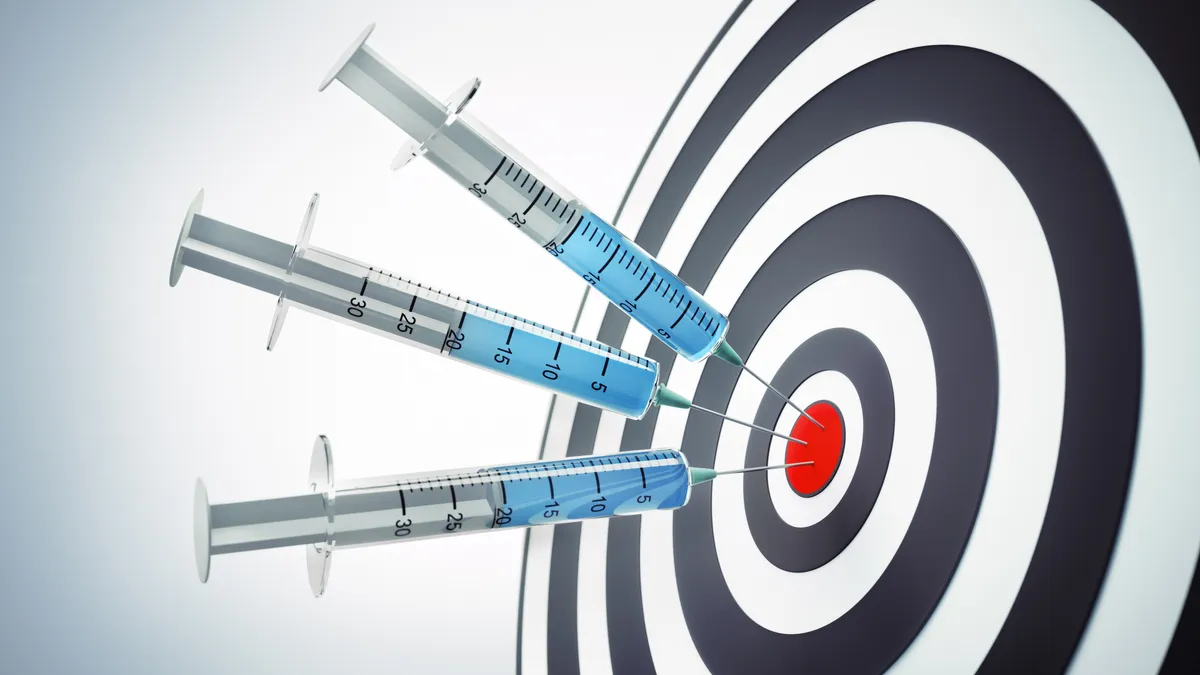For well over a year, the FDA hasn’t granted any antibody-drug conjugate approval — the last one over the line was Immunogen’s Elahere for platinum-resistant ovarian cancer in November 2022. But the industry’s pipeline is set for more.
Over 80 ADC candidates are in phase 3 development, according to the healthcare management consulting and technology firm ZS.
In addition to treating a wide array of oncology targets — including breast, non-small cell lung, gastric and esophageal cancers — ADCs can be a less risky bet than other therapies. ZS estimates the probability of “technical and regulatory success” is 48% for ADCs currently in phase 3, compared to 41% for “oncology overall.”
This potential for patients and drugmakers has made ADCs one of the buzziest modalities in pharma and placed the technology at the heart of several big-ticket deals in recent years, including AbbVie’s $10 billion purchase of ImmunoGen and Pfizer’s $43 billion tie-up with Seagen.
While ADCs have already established ROI for many pharmas — ZS estimates global sales for the approved ADCs reached $7.5 billion in 2022 — there’s still a need to make them better. To boost outcomes and overcome lingering clinical challenges such as off-target toxicities, drugmakers are adjusting development strategies.
“ADCs have done a good job of improving response rates, but we believe there’s still room for improvement."

Jonas Helma-Smets
Chief scientific officer, Tubulis
Some established leaders in the ADC space, such as Daiichi Sankyo, plan to test their drugs in combination with immunotherapy heavy-hitters like Merck & Co.’s Keytruda, while also working towards approvals in earlier lines of care.
Other developers are tinkering with the basic three components of ADCs — an antibody that hunts cancer cells, a cytotoxic payload that acts as a warhead and a linker molecule — to improve the technology. In a market that now includes most major players in pharma and a vast array of plucky upstarts, these emerging candidates have the potential to create longer lasting and less toxic therapies.
Here's how three rising companies in the ADC space are looking for an edge.
Genmab zeroes in on a novel linker tech
A long-time antibody specialist, Genmab is a natural fit for the ADC arena. In 2021, it snagged one if its first ADC wins when Tivdak, developed with Seagen, won an accelerated approval for metastatic cervical cancer. The ADC snagged a full nod in April based on phase 3 data showing it improved survival by 30% compared to chemo.
Genmab also deepened its commitment to developing ADCs this year through a $1.8 billion buyout of ProfoundBio. The deal will marry ProfoundBio’s ADC platform with Genmab’s antibody therapies and “suite of proprietary technology platforms.” The merger also pumped several assets into Genmab’s pipeline, including a phase 2 ADC called Rina-S.
“We think we can be a leader in gynecological cancer and differentiated in the market.”

Anthony Mancini
Chief operating officer, executive vice president, Genmab
Developed to treat ovarian cancer and other FRa-expressing tumors, the company believes its special sauce — a novel linker technology — will offer a favorable safety profile over rivals such as Elahere, which carries a boxed warning for numerous ocular toxicities, including some that are severe.
“[Rina-S] is a second-generation ADC [with] a cleavable hydrophilic linker … this translates into none of the side effect profiles of the first ADCs,” Anthony Mancini, executive vice president and chief operating officer at Genmab, said. “With Rina-S, we’re not seeing ocular toxicities.”
As its ADC portfolio grows — the company has three candidates in the clinic including Rina-S — Mancini said Genmab is staking its claim in oncological women’s health.
“With Tivdak on the market for cervical cancer … we’re excited about Rina-S because these are two drugs in our target audience,” he said. “We think we can be a leader in gynecological cancer and differentiated in the market.”
Sutro Biopharma aims for multiple ADC breakthroughs
Sutro Biopharma’s lead asset luvelta could also become a competitor in the ovarian cancer landscape. In particular, the biotech aims to leverage the ADC in patients with “low to medium” levels of FRa expression, and won a fast track designation for the candidate, which is now in late-stage development for ovarian cancer, in 2021.
But the company sees broad potential in indications including non-small cell lung cancer and other solid tumors.
What sets Sutro’s approach apart from the rest of the field is that other ADCs use a “heterogenous mixture of molecules,” the company’s CEO, Bill Newell, said.
“We started pioneering the notion that if you made a homogenous molecule, you could improve the medicines to be more beneficial to more patients and have less toxicity,” he said. “In the ADC field, that wasn’t possible when we started 13 years ago.”
Sutro hasn’t indicated when it’s going to file for a luvelta approval, but if it hits the market, Newell said it’s targeting a patient pool of FRa-expressers in ovarian cancer that’s “more than double” that of Elahere.
And while it leads its own development for luvelta, the company has pulled together a string of partnerships for other pipeline hopefuls, including a $900 million deal with Ipsen to develop a preclinical ADC for solid tumors announced in April.
The company also teamed up with Astellas Pharma in 2022 to advance immunostimulatory ADCs (iADCs), a potential breakthrough approach that Sutro said is “intended to deliver two different drugs directly to the tumor to not only kill tumor cells but also locally prime an immune response to the patient’s particular tumor cells.”
Tubulis looks to payloads for a more durable ADC
A spinoff born from two German academic institutions, Tubulis has set its sights on next-generation payloads.
The company has six assets in preclinical development for solid cancers and “one of the broadest platforms in the field right now,” according to chief scientific officer Jonas Helma-Smets.
Tubulis’ suite of platforms can “unlock novel payloads for the development of versatile and customizable ADCs,” the company said in a press release.
“We have a huge design space given by the technology in terms of drug-to-antibody ratio, different technologies to conjugate the antibody [and] we have novel technologies to explore other payloads,” he said.
Investors have been receptive to the idea. This spring, Tubulis raised $138.8 million to back pipeline development and “clinical proof of concept” for its two lead candidates.
As the company moves towards clinical trials, Helma-Smets said Tubulis’ technology could decrease the chances of off-target effects by “ensuring [it doesn’t] lose the payload,” while also creating a more durable treatment.
“We’ve shown in preclinical animal models that we have a long-lasting effect in cancer-bearing mice, and that is a differentiating factor,” he said. “ADCs have done a good job of improving response rates, but we believe there’s still room for improvement. That durable response is what we hope to translate to the clinic.”



















